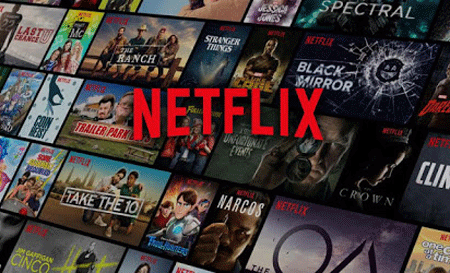What Netflix must do to survive
Three years ago, Center director Jeffrey Cole predicted that after a charmed decade, Netflix, faced with rising competition, might be navigating treacherous waters. Cole’s prescription for what the streaming giant needed to do in 2019 is even more relevant today.
By Jeffrey Cole
 Until two weeks ago, Netflix has led a charmed life. It successfully transformed itself from a DVD-by-mail competitor to Blockbuster Video (which turned down the opportunity to buy Netflix for $50 million) into the first superstar streaming service.
Until two weeks ago, Netflix has led a charmed life. It successfully transformed itself from a DVD-by-mail competitor to Blockbuster Video (which turned down the opportunity to buy Netflix for $50 million) into the first superstar streaming service.
For years, Netflix had complete access to the best product from all the Hollywood studios. Its unparalleled success in attracting subscribers across the globe then gave it massive budgets to create original programming exclusively for Netflix.
Disney, realizing that by selling its content to Netflix it was creating a competitive monster, decided to stop making its content available outside the company. The other studios followed suit. Soon, it became clear they would start their own streaming services. Still, Netflix had a budget of $20 billion (this year) to fund its own content; Netflix grew like a prairie weed when it had almost no competition for the consumer’s wallet.
Reprinted below is a piece I wrote almost three years ago, in July of 2019, when it should have become clear to Netflix that it would need to work much harder to attract new subscribers and to retain the ones it already had. I wrote that column four months before the introduction of Apple TV+ and Disney+. HBO Max, Peacock, and Paramount+ were still a little further in the future.
If my longtime prediction—that most families will pay for about 2.5 video services—is correct, then in the coming months the competition for content and subscribers will become fierce.
The pandemic delayed this shakeout for two years because there was so much demand for content. Viewers were reluctant to give up or switch streaming services. Watching upwards of 10 hours of television a day, we had time for everything.
Those days are over.
Since its April 19th earnings call in which it announced its first significant loss of subscribers, Netflix’s stock plunged from $348.61 to $190.36 per share, a loss of more than 45% of its market cap.
I reprint this column (something I have never done before), not to prove how well I could see three years into the future, but to show how the all the warning signs for Netflix were there in 2019 — before the pandemic and before new competitors arrived. The argument is as timely and important today as it was three years ago.
If I were writing the column today (rather than re-printing it), I would change nothing but the numbers for subscribers and budgets. What was a warning in 2019 is now a blaring alarm. Netflix’s way forward in this new hyper-competitive environment is as clear today as it was three years ago.
The Streaming Wars have begun. The service at the greatest risk and with the most to lose is Netflix.
__________________________________________________
The disruption of Netflix: a plan for its survival
With new streaming services competing for audience attention and subscription dollars, and studios reclaiming its content, can Netflix survive? Center founder Jeffrey Cole has five suggestions.
(Originally published July 20, 2019: https://www.digitalcenter.org/columns/netflix-rough-times)
By Jeffrey Cole
The Streaming Wars have begun. The service at the greatest risk and with the most to lose is Netflix.
Ever since it made the awkward transition from the “Red Envelope” business into streaming eight years ago, Netflix has been on an unprecedented glide path to success. Netflix is the unchallenged leader of the subscription streaming category that it largely created. Hulu (with 25 million subscribers compare to Netflix’s 60-65 million in the U.S.) competes to be the streaming service in addition to Netflix, which has a $12 lock on the consumer’s wallet.
 Netflix’s mix of recent theatrical films (similar to how HBO and Showtime began) coupled with old television series and $12 billion in original programming has proved to be an unbeatable combination. When you factor in all the password-sharing among families, college students, and friends, Netflix may actually have close to 80 million viewers in the U.S. and over 190 million worldwide.
Netflix’s mix of recent theatrical films (similar to how HBO and Showtime began) coupled with old television series and $12 billion in original programming has proved to be an unbeatable combination. When you factor in all the password-sharing among families, college students, and friends, Netflix may actually have close to 80 million viewers in the U.S. and over 190 million worldwide.
But Netflix’s days of being unchallenged are over. Several of the key studios, alarmed at the monster competitor they helped create by selling Netflix their content, are now pulling that content back as they start their own competitive streaming services. This year Disney+ will go online, followed in the next year or so by Warner Bros., Universal, Apple, and likely several more. In three years, the consumer will have to spend $40-50 a month to get what they have been getting in one place from Netflix for $10.
The threat to Netflix as it faces serious competition and loses some of its most important programming (Marvel, Pixar, Disney, Star Wars, DC Comics, Friends, and The Office to name a few) is that it begins to look just like the other services. In that world, the only streaming channel that stands out is Disney because of its unique brand that transcends whatever content happens to be popular at the moment.
With so many services about to enter the market, we may move to a phase where we add or drop channels every few months as they premiere or finish content we really like (e.g., Game of Thrones). Netflix has had so much content that the decision to subscribe has always been a no-brainer. But as the best programs are divided among several or more channels, viewers will begin to chase content rather than channels. The wild west of streaming is beginning.
Netflix has a lot to protect. It has only been able to buy so much existing and original content because it has grown so fast across the globe. Serious competition for content and the consumer’s wallet will slow that growth. There is a real risk of a downward spiral for Netflix. Its survival as the market leader is by no means assured.
Netflix, the great media disruptor, is about to get disrupted. When most industries are disrupted, instead of looking at the new opportunities the disruptor has identified, they desperately cling to the old way of doing business. Netflix is going to have to do what it has never done before: fight for its customers and understand that it may not control most of the market in the future.
The lights should be burning all night at Netflix as it learns to compete in a streaming world where its dominance is no longer guaranteed. Disney could rival Netflix’s subscriber base in 12-24 months, and it has the advantage of moving its content into theme parks, retail, and elsewhere to achieve far more synergy than Netflix.
If Netflix is not in survival mode, it should be. These are the things it can do to remain a leader–if not the leader–in the streaming world:
1. Make less but better original programming. Netflix’s strategy is to create so much content that there is never a lull between the end of a series or original movie and the premiere of another. Its plan never to experience what HBO faced with the end of The Sopranos, or more recently Game of Thrones, is to bombard viewers with so much content they never consider giving up their subscriptions.
The problem is that much of Netflix’s original content is forgettable and just not very good. Of course, in that $12 billion is some great content (The Crown, House of Cards at its peak, and Stranger Things), but much is bland and generic. With a spend of about $2.5 billion, HBO creates better programming (although far less of it) than Netflix. That is why HBO usually wins more Emmy Awards on 1/5 the budget of Netflix (this year they tied).
One of the great advantages of non-original programming (movies and TV shows) is that Netflix can pick from content that has already been popular in its theatrical or television release. This is the content it is about to lose. It is time for Netflix to pay far less attention to the amount of programming it creates and instead focus on fewer, higher quality programs with better marketing so that viewers can fully digest each premiere.
2. Start paying a back end to continue to attract the best content. The dream of any television producer is to produce at least 100 episodes of a series (historically that’s five seasons) so they can be sold into syndication. That’s where the real money is. The creators and producers of The Big Bang Theory, Friends, and Seinfeld have made hundreds of millions of dollars through this system.
Under the old model, the broadcast networks financed the production of the series (or most of it), but the future revenue from syndication and streaming went to the creators and the studios that produced the content. Netflix pays large production salaries so that it doesn’t have to share the back end.
For Netflix’s creators and studios, there is no syndication to sell to, since the streaming channel keeps the program in perpetuity. To continue to attract the best creative talent moving forward, Netflix may have to agree to start sharing revenue. To do so, it may have to lift the veil of secrecy over their data and create new definitions of the economic life of content for owners after the original premiere and share viewing information.
3. Stop ending series at the end of the second or third season. Since it doesn’t syndicate (see reason #2), Netflix has less motivation to get to 100 episodes of a series. It has canceled many series that appear to be successful (although Netflix doesn’t release ratings) at the end of the second or third seasons, frustrating fans.
This sirius interuptus has recently occurred with Santa Clarita Diet, American Vandal, and One Day at a Time (which Netflix claimed to love; it recently found a new home). In fairness, a handful of Netflix series have made it past the three-year mark (House of Cards, Grace and Frankie, and surely The Crown will). Beyond frustrating fans, prematurely ending television shows prevents Netflix from compiling hundred(s) of episodes of content that is important to viewers– the very content they will lose soon in Friends and The Office.
4. Consider advertising as a way to keep costs down. It goes against Netflix’s DNA to accept advertising, and fans will certainly threaten to quit the service if ads arrive. But without advertising, it will be difficult, if not impossible, for Netflix to raise its rates more than a dollar or two a year.
In a world of serious competition, Netflix will not be able to go head-to-head with the new services for great content and talent without increased revenue. Advertising, or a hybrid model like Hulu, may be inevitable. The Center’s work on television over the past generation shows that while people complain about advertising, what they really don’t like is advertising that interrupts programs. They are far more tolerant of advertising between programs. If subscribers see that kind of advertising as a way to keep costs down significantly, their attitudes will likely change.
5. Lock down the uncommitted players. Disney, Warner, and Universal have announced they will be creating streaming channels. So far, there have been no announcements from Paramount or Sony. They are the smallest of the major studios and undoubtedly are waiting to see how the landscape will change.
Although smaller, they are still full studios that make major motion pictures and television, and have sound stages, talent, and crews to support that programing. Like the broadcast networks that mainly run the programming they own or co-own, Disney, Warner and Universal’s streaming channels will do the same. Sony and Paramount can easily become major suppliers of content to Netflix as it loses other studio’s content. Netflix should lock up long-term relations with them as well as anyone else that produces content.
Netflix, the great media disruptor, is about to get disrupted. When most industries are disrupted, instead of looking at the new opportunities the disruptor has identified, they desperately cling to the old way of doing business. Netflix is going to have to do what it has never done before: fight for its customers and understand that it may not control most of the market in the future.
Unwillingness to accept that they may lose market share keeps most companies from making the difficult changes that keep them competitive (such as music, taxis, and banks). With very few exceptions, successful companies rarely disrupt themselves, and change to meet new competition.
For Netflix, it’s going to be a tough road ahead.
____________

Jeffrey Cole is the founder and director of The Center for the Digital Future at USC Annenberg.
See all columns from the center.
May 4, 2022

